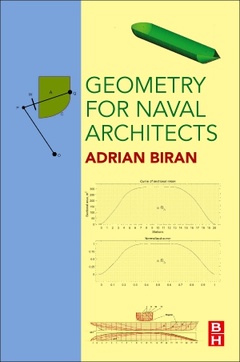Geometry for Naval Architects
Auteur : Biran Adrian

Geometry for Naval Architects is the essential guide to the principles of naval geometry. Formerly fragmented throughout various sources, the topic is now presented in this comprehensive book that explains the history and specific applications of modern naval architecture mathematics and techniques, including numerous examples, applications and references to further enhance understanding. With a natural four-section organization (Traditional Methods, Differential Geometry, Computer Methods, and Applications in Naval Architecture), users will quickly progress from basic fundamentals to specific applications.
Careful instruction and a wealth of practical applications spare readers the extensive searches once necessary to understand the mathematical background of naval architecture and help them understand the meanings and uses of discipline-specific computer programs.
Section I: Traditional Methods 1. Elements of descriptive geometry 2. The hull surface - Graphic definition 3. Geometric properties of plane figures
Section II: Differential Geometry 4. Parametric curves 5. Curvature 6. Surfaces
Section III: Computer Methods 7. Cubic splines 8. Geometrical transformations 9. Bezier curves 10. B-splines and NURBS 11. Computer representation of surfaces
Section IV: Applications in Naval Architecture 12. Applications to naval-architectural software 13. Hull transformations by computer software 14. Conformal mapping 15. Answers to selected exercises
Entry-level naval architects and researchers working in ship design and developing/using ship design software; supplemental use for students of naval architecture and marine engineering
Dr. Biran has also worked as a project instructor in Romania at the Technical Military Academy and in Israel at the Ben Gurion University. He has taught subjects including Machine Design, Engineering Drawing, and Naval Architecture. He has authored several papers on subjects such as computational linguistics and computer simulations of marine systems and subjects belonging to Ship Design. He is also the author of Ship Hydrostatics and Stability, Second Edition (BH).
- Explains the basics of geometry as applied to naval architecture, with specific practical applications included throughout the book for real-life insights
- Presents traditional methods and computational techniques (including MATLAB)
- Provides a wealth of examples in MATLAB and MultiSurf (a computer-aided design package for naval architects and engineers)
Date de parution : 11-2018
Ouvrage de 524 p.
15x22.8 cm
Thème de Geometry for Naval Architects :
Mots-clés :
Analytic function; Angle between lines; Centre of curvature; Centrifugal acceleration; Complex number; Conformal mapping; Coordinate lines; Curvature; Curves on surfaces; De Moivre's theorem; Developable surfaces; Earth sphere; Elastic line; Envelope; Evolute; Explicit equations; Extended Lewis forms; First fundamental form; Gaussian curvature; Geodesic; Geodesic curvature; Great circle; Imaginary unit; Implicit equation; Involute; Isometric mapping; Joukovski transformation; Laplace equation; Latitude; Lewis form; Longitude; Mean curvature; Meridian; Metacentric evolute; Metacentric radius; Monge form; Normal curvature; Osculating circle; Parallel; Parametric representation; Polar form (of complex number); Principal curvatures; Principal directions; Radius of curvature; Ruled surfaces; Second fundamental form; Surface; Surface of tangents; Theorema egregium
